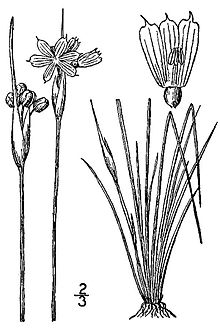| Sisyrinchium campestre | |
|---|---|

| |
| A botanical illustration from Illustrated flora of the northern states and Canada by Nathaniel Lord Britton and Addison Brown | |
| Scientific classification | |
| Kingdom: | Plantae |
| Clade: | Tracheophytes |
| Clade: | Angiosperms |
| Clade: | Monocots |
| Order: | Asparagales |
| Family: | Iridaceae |
| Genus: | Sisyrinchium |
| Species: | S. campestre
|
| Binomial name | |
| Sisyrinchium campestre | |

Sisyrinchium campestre, the prairie blue-eyed grass or white-eyed grass,[2][3] is a small herbaceous perennial plant in the iris family, native to prairie and meadow in the central United States and in extreme southern Manitoba.[4]
Prairie blue-eyed grass is one of the more drought tolerant species in the genus. It blooms in late spring and early summer for about three weeks.[5] The flowers are white to pale blue, with yellow centers. They have six tepals 7 to 12.7 mm (0.28 to 0.50 in) long that have rounded ends with a sharp point in the center.[4] The flowers are borne on slender pedicels (stems) in an umbel enclosed in two bracts at the top of an unbranched flat stem. The leaves are grass-like, 3 to 10 inches (8 to 25 cm) long and 2 to 3 mm (0.08 to 0.12 in) across, and the flower stem is about as long as or a little longer than the leaves. The root system is coarse and fibrous. A plant produces offsets and forms a dense clump over time.[5]
- ^ "Sisyrinchium campestre". International Plant Names Index (IPNI). Royal Botanic Gardens, Kew; Harvard University Herbaria & Libraries; Australian National Botanic Gardens. Retrieved July 16, 2018.
- ^ Chayka, Katy; Dziuk, Peter (2016). "Sisyrinchium campestre (Prairie Blue-eyed Grass)". Minnesota Wildflowers. Retrieved July 16, 2018.
- ^ Haddock, Mike (2018). "White-eyed grass". Kansas Wildflowers and Grasses. Retrieved July 16, 2018.
- ^ a b Cholewa, Anita F.; Henderson, Douglass M. (2002). "Sisyrinchium campestre". In Flora of North America Editorial Committee (ed.). Flora of North America North of Mexico (FNA). Vol. 26. New York and Oxford: Oxford University Press – via eFloras.org, Missouri Botanical Garden, St. Louis, MO & Harvard University Herbaria, Cambridge, MA.
- ^ a b Hilty, John (2020). "Prairie Blue-Eyed Grass (Sisyrinchium campestre)". Illinois Wildflowers.
